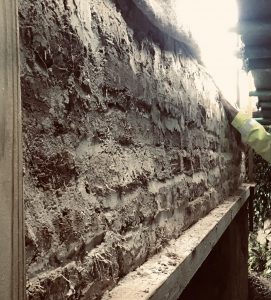Whether it’s a cob wall rebuild, an extensive cob repair or a cob new build, cob blocks are the go-to product. By using pre-formed cob products such as cob blocks, the builder/s can be assured [that once in situ] they can accommodate plasters and renders very soon afterwards. Here at Earth Blocks Ltd in Cornwall we pride ourselves on the fact that our cob blocks are manufactured to the highest standards…..and this includes the uniformness of our products.
Our standard cob block measures 100mm x 385mm x 215mm
Typically, cob blocks are laid flat during construction (not always though!) and are bonded together using either hydraulic or non-hydraulic lime mortars. So, how much mortar is required to lay cob blocks? Well, this will depend on the cob blocks being used. If the cob blocks are irregular in shape and form, more mortar is likely to be required to enable levelling and straightness [of the wall].

This is an example of cob block walling
where the cob blocks are not uniform and
consistent in their dimensions. Cob block
walling like this can use up to 50% more mortar.
Research shows that, on average, building conservation material stockists that sell cob blocks AND lime mortars, recommend 1000kg of mortar to lay 150 cob blocks. Understandably, the user wouldn’t want to run out of mortar before construction has finished and equally, the seller wouldn’t want to under-estimate project material requirements. We accept that both consumer and supplier positions should be unified and respected. Earth Blocks Ltd are not suppliers of lime-based products, we manufacture and supply pre-formed cob products only. But how much lime mortar would we recommend for 150 of our cob blocks?

Cob block walling demonstrating the accurate dimensions of our cob blocks
Conservatively, we would recommend 400kg of lime mortar to lay 150 of our 100mm cob blocks on their flat. That is a consumer saving of over 50%, potentially less CO2e transporting material to site, less packaging, less on-site mixing and so on. However, I must make it clear that this article isn’t a pop at the stockists, it’s primarily demonstrating our belief and ethic in sustainable building techniques/materials and our unique methods of manufacture. Next post will be exactly same, only next time it’ll emphasize on the cost-saving properties of using our cob blocks when it comes to renders and plasters.
To prepend this post, not only are our cob blocks superior – they’re one of the cheapest too!







